#macroterra
Explore tagged Tumblr posts
Text
Possum Cat - Whoapossums Of The Late Origocene
20 Million Years P.E. (The Late Origocene)

The Whoapossums, an lineage of Betabies that took to the trees and became quite the skilled climbers, with an semi-opposable thumb and an flexible tail, now In the Late Origocene they have become even more skilled, with an even more flexible tail and fully opposable thumbs.
The Bright-Eyed Nightpossum (Simiadidelphidae Oculislucidis) Is an skilled nocturnal insects hunter, using Its sensitive, big eyes and ears to detect insects amongst the darkness.
An Whoapossum that went Into the different direction tho Is the Capped Fruitpossum (Fructusdidelphidae Caputgerens), an frugivore that climbs amongst the treetops In search for brightly colored fruit, which they fortunately can spot with ease, as similiar to the Monarch Pterobats the frugivorous diet of the Fruitpossums favored the developement of color vision.
But the most unique of the Whoapossums of this time would be the Fossums, the Pocket-Paw Fossum (Ungulatus Marsupialiscattus) Is one of them, while Whoapossums started to get more comfortable In the treetops, the Fossums started to settle on the ground again, they are still amazing climbers, theres no doubt In that, but they will also spend alot of time on solid floor.
Fossums are excellent small game hunters, they especially shine In hunting Pterobats, Mausbies, Scoppels and even Shrish.
As you might have noticed, the Fossums favor the similiar prey as the earthern cats and this Is not where the convergence ends.
They posses carnassial teeth as molars and retractable claws.
Their retractable claws are a life safer as they rely on them alot to catch prey and climb.
Them moving on rough surfaces could risk the claws trimming to much to be usable for their tasks.
#macroterra#speculative biology#speculative evolution#spec evo#speculative zoology#evolution#world building#creature design#spec bio#art#digital art#original species
10 notes
·
View notes
Text




IS THIS A BUTTERWORT???!?!????
HAVE I FINALLY BEEN BLESSED?!?!?!?!!?! 😭
@carni-seeds @sundewstars @sneakerorchid @carniplantgirlie @mrbadhairday @macroterra
#bog garden#bog#terrarium#help#id#identification#identify#pinguicula#carnivorous#carnivorousplant#carnivourousplant#carnivorousplantclub#science#plantblr#houseplants#butterwort#liverwort#???
12 notes
·
View notes
Text
Flap Your Wings! - The Pterobats
20 Million Years P.E. (The Late Origocene)
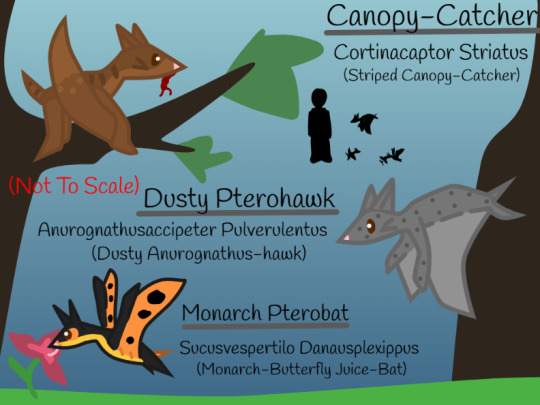
The lack of flying vertabrates has greatly encouraged the developement of powered flight In the Protein Gliders of the Middle Origocene.
Now their descendants, the Pterobats have dominated the planet as the dominant flyers.
The more basal species are airborn insect-catchers like the Canopy-Catcher (Cortinacaptor Striatus), still very similiar to their ancestor.
But some Pterobats started to focus on larger prey, similiar as the Birds of prey on earth there are also Pterobats of prey, as of right now they are rather small and thus only hunt small prey like Mausbies or other smaller Pterobats.
One of those Pterobats of prey Is the Dusty Pterohawk (Anuroganthusaccipeter Pulverulentus), flying over open plains In search for prey.
But truly the most unique of the Pterobats In this time would be the Monarch Pterobat (Sucusvespertilo Danausplexippus), as It Isnt even In the slightest predatory.
The Monarch Pterobat Is rather interested In sweet foods like fruits and nectar. Another unique factor In these Pterobats Is their ability to see colors, colorvision appears quite rarely In mammals and usually only evolves In frugivores to find brightly clored fruits and since the Monarch Pterobats are fans of bright colored fruits and flowers, natural selection favored them color vision.
Their color vision eventually allowed them one more trait except to find food with ease, communication.
With their bright orange-yellow colors on their otherwise black fur, their colors quite pop and make themselfs visible to other members of their species.
You might think that these colors might attract predators as well, but the predators In question dont posses color vision themselfs and since Monarch Pterobats are mostly adorned with black and orange colors they can actually be pretty hard to spot, or well, atleast not easier then other Pterobat species.
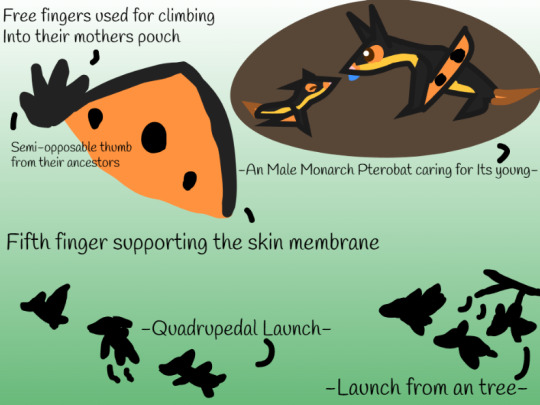
Pterobats get their name from their unique flying build which resembles that of early Pterosaurs.
Since the Pterobats are marsupials, they heavily rely on their claws In order to get Into their mothers pouch.
Thus natural selection has favored an build for flight which retained most of the claws.
Unlike the placental Bats from Earth they only use a single finger to support their skin membrane.
Being an flying marsupial although has more issues then just the claws, the joeys In the mothers pouch can put on quite alot of weight and hinder their flight capabilites.
Although they have found an solution for this issue as well.
Pterobats will stay together as an mated pair until their joey are old enough, when the joeys are getting to heavy for the mothers pouch, she will leave the young with the father, who will then find an safe spot that will hide the joeys, the father will then also feed their offspring and keep them safe untill they are old enough to depart.
Pterobats have 2 ways of takeoff, either from the solid ground by using their front legs to push them into the air, or hang and swing from trees or cliffes.
#macroterra#speculative evolution#spec evo#speculative biology#speculative zoology#evolution#world building#creature design#art#digital art#original species#specbio
5 notes
·
View notes
Text
Macroterra - The Early Origocene
0 Million Years P.E.
1 Million Years P.E.
#speculative evolution#spec evo#speculative biology#speculative zoology#art#digital art#evolution#world building#creature design#spec bio#macroterra
2 notes
·
View notes
Text
The Ivory Of Life - The Womboars
20 Million Years P.E. (The Late Origocene)
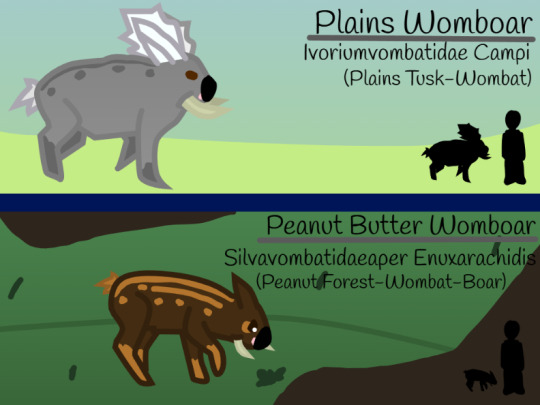
The Nomwats were the first large scale herbivores and thus faced great success, the success of one specific Nomwat species Is incredibly well reflected In their descendants.
The Womboars are descendants of the Koala-Nosed Nomwat, and species that has specialised In eating though vegetation, as more and more herbivores emerged the plants got only thougher trying to shake of the herbivores, but the Koala-Nosed Nomwats were already In the niche to graze the though grasses, thus It was an easy adaption to feed on these new world grasses.
The Womboars most recognizable trait are their tusks which have formed from their molars, their molars grow throughout their entire lifes, kinda like the Mausbies incisors, this helps them to chew trough the tough vegetation.
The tusks are used for self-defense, rooting up plants, display and fighting rivals.
The Plains Womboar (Ivoriumvombatidae Campi) Is one of the most dominant grazers of this time, males have harrems of females over large territories, If territories are overlapping the males will fight, whoevers tusks break first will loose.
Plains Womboars also posses long tuffed ears which they use as flag posts for communication.
These flag post structure usually evolve from tails, but Womboars have too short tail to be utilized, so the ears are the next best thing.
An smaller Womboar species Is the Peanut Butter Womboar (Silvavombatidaeaper Enuxarachidis), these forest dwellers are smaller but also more agile, this although does not mean that they wont use the tusks when backed In a corner.
The Peanut Womboar Is an herbivore which feast on the forest grasses, seeds and roots.
#macroterra#speculative evolution#spec evo#speculative biology#speculative zoology#evolution#world building#creature design#art#digital art#spec bio#original species
5 notes
·
View notes
Text
Blubb Blubb - The Shrish
20 Million Years P.E. (The Late Origocene)

While Macroterra Is a planet of Bilbies, the invertabrates, which have been seeded to sustain the ecosystem, have changed over the years as well and the most succesfull and dominant ones would be the Shrish. Descendants of Planktonic Krill, they have come to dominate the oceanic ecosystem.
The Shrish started out as shrimp like swimmers that propelled themselfs through the water with feathery legs, Shrish like these still exist, the OJ Reefer (Pseudocaris Citrinasuccus) Is an good example. But some didnt bother to actively swim and become bottom feeders, like the Gravel Trilokrill (Trilobitacaris Fundusmaris).
Although some Shrish have optimized their swimming abilities,
some Shrish would eventually develop a shorter and more streamlined body, and give rise to active swimmers that propelled themselves with undulating waves of their abdomen and tail. Becoming a more efficient means of propulsion, these shrish would eventually modify their rearmost swimming legs along with their tail fan into a caudal fluke of sorts.
But these fluked Shrish didnt just stop there, as another adaption proved efficiency, pseudo-jaws.
These pseudo-jaws are formed from their elongated barbed rostrums and first front legs.
With these they can easily catch slippery prey an apply pressure to crack their hard shell.
two of these jawed Shrish are the Great White Shraw (Pisciscaris Magnusalbus) and the Cherry Shrimpede (Centipedecaris Cerasus).
Both are fearsome predators In their own right, the Shrimpedes are small slender Eel-like ambush predators, while the Great White Shraw are rather large at 1 meter In size they are true giants among the arthropods.
But not all of those jawed Shrish are predators, the Green Weedpicker (Herbariumcolligens Viridis) Is an rather peacefull grazer, using their jaws to pluck and crush tough algea, seaweed and corals.
#speculative evolution#spec evo#speculative biology#speculative zoology#evolution#world building#creature design#art#digital art#spec bio#macroterra
5 notes
·
View notes
Text
Remember Your Ancestors - The Sandy Betaby
10 Million years P.E. (The Middle Origocene)
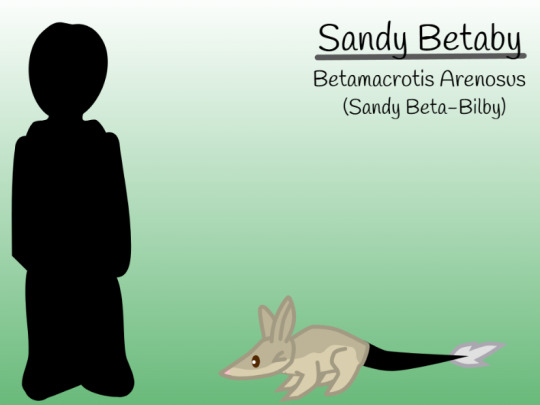
10 Million years into the history of Macroterra many descendants of an single animal, the Greater Bilby have risen and fallen.
Lurking In the shadows of various succesfull lineages there Is one that seems like It Isnt going to stick around that much longer.
The Betabies (Family: Betamacrotidae) were one of the lineages which emerged relatively early In Macroterras history and given rise to even more lineages like the Hedgey´s, Whoapossums and Bilcoons. The Betabies themselfs though are kinda victims of their own succes as they find themselfs In tough competetion with their relatives.
As of the Middle Origocene their Is only one Betaby species alive, the Sandy Betaby (Betamacrotis Arenosus).
It manged to stick around as an oppurtunistic desert dweller, but know there are other oppurtunistic more adapted species like Jerbaroos and Needle-Manes.
While It Is tragic that the Betabies will soon fade away from the face of Earth, or Macroterra, this Is just life, extinction Is the rule and evolution Is the exception.
But the Betabies managed to produce descendants that do quite well for themselfs, so while they themselfs will be gone, their lineage will be continued.
#speculative evolution#spec evo#speculative biology#speculative zoology#evolution#world building#creature design#art#digital art#spec bio#macroterra
2 notes
·
View notes
Text
A Coin Has 2 Sides - The Shrovels
10 Million Years P.E. [The Middle Origocene]

The Measels are some of the top predators In this time, excellent meso predators and small game hunters, which Is kinda surprising considering they have evolved from the pretty cowardly Bepples.
Small insectivores which spend most of their time underground hiding from larger carnivores.
While the Measels have gotten quite a glowup, they are not the only descendant the Bepples produced.
Next to the Measels there also were the Shrovels (Family: Talpiamacrotidae).
These small critters are alot more like their ancestors, spending most of their lives underground feeding on burrowing insects.
They have heavily converged with earthern moles, possesing poor eyesight, large shoveling claws and an bald nose to push away dirt.
The Shrovels are an not very diverse group with only very few species, the most widespread one would be the Balding Shrovel (Talpiacopia Calvus).
They are an very basal species of the Shrovel fitting the description very well.
While there currently Isnt much to see with their kind, this could soon change.
#speculative evolution#spec evo#speculative biology#speculative zoology#world building#evolution#art#digital art#creature design#macroterra
2 notes
·
View notes
Text
Your Gnawing On My Nerves - The Mausbies
10 Million Years P.E. [The Middle Origocene]
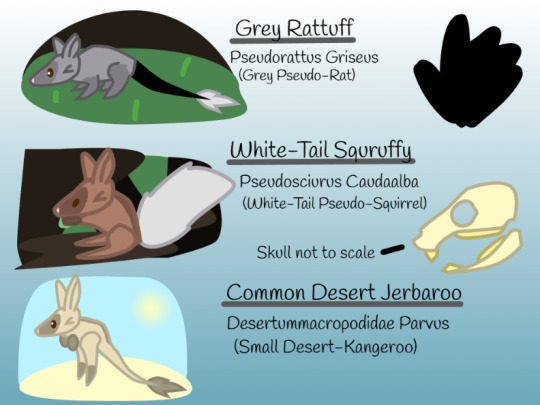
The Poochy Seedeater Is an Bilby which evolved 9 million years ago and became an specialized seed eater.
Now In the Middle Origocene, Its descendants the Mausbies (Family: Roderemacrotidae) took the place as the most dominant and widespread seed eating critters.
What makes them unique Is their convergence with earthern rodents. Possesing strong incisor teeth that grow throughout their lifes, perfect for gnawing on hard seeds.
They are also of rather small size to avoid competetion with larger seedeaters like Bilcoons.
Another rodent like trait from the Mausbies Is their quick reproduction, they can raise up to 8 joeys In their pouch.
The joeys also mature pretty quick and as soon as the litter Is done baking, the mothers usually have the next litter.
This fast way of reproduction Is some sort of defense mechanism of their part, which doesnt protect the single individuall but rather the species as a whole.
Due to their small size their are an prime target to the abundant meso predators or young large game predators.
This lifestyle of quick reproduction also causes Mausbies to have an not very long natural lifespan once again an trait akin to earthern rodents, since mausbies are often wasting alot of their energy birthing and nurturing their young or risking getting spotted by predators when out searching for mates.
The Grey Rattuff (Pseudorattus Griseus) Is one of the more basal Mausbies. Being incredibly widespread, their found all over Macroterra (except In the desert). They are omnivores but are specialized In hard seeds, which make up the most part of their diet.
Pretty typicall for Mausbies, the Grey Rattuffs live In large family colonies.
The White-Tail Squruffy (Pseudosciurus Caudaalba) Is an arboreal entry of the Mausby family.
They feed on acorn like seeds growing on the trees or the seeds of stonefruit.
The White-Tail Squruffy Is also pretty unique In the term of social behavior as they are solitary rather then living In family colonies.
The Common Desert Jerbaroo (Desertummacropodidae Parvus) Is an Mausby that has moved Into Macroterras desert.
Mausbies are unique for their bipedal hopping way of locomotion similiar to earthern Kangeroo Rats.
Their bipedal hopping Is an energy efficient way of locomotion In their hot desert climate.
Even tho their hopping Is optimal for the desert there are also some Jerbaroos that live outside the desert, although they are not as succesfull there.
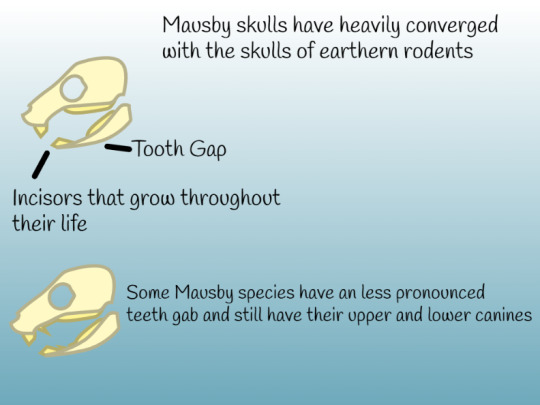
-Mausby skulls-
2 notes
·
View notes
Text
Big Forest, Smaller Grazers - Bilbeelopes and Scoppels
10 Million Years P.E. [The Middle Origocene]
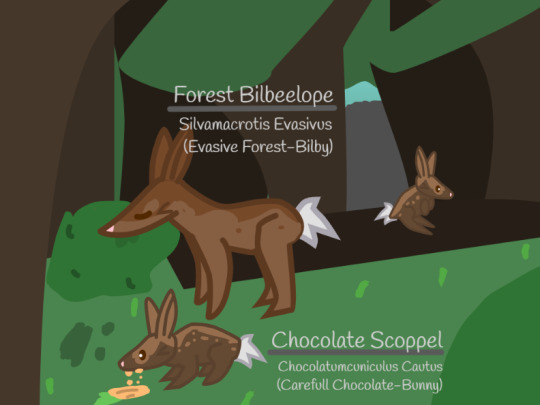
In an temperate forest of Macroterra we find an quite peacefull scenary, as 2 herbivorous Bilbies enjoy an meal In peace without any of their natural predators around.
The larger Bilby feeding on an bush Is an Bilbeelope (Family: Bovidaemacrotidae) specifically an Forest Bilbeelope (Silvamacrotis Evasivus). The Bilbeelopes are just like the Nomwats descendants of the Shorts-Tail, Unlike their stockier-build cousins, they prefer to eat from shrubs and small trees. Their interest In those food sources helps them to avoid competetion with the Nomwats.
The other small critters In the picture might look like the earthern bunnies, but like all the vertebrates they are descendants of Bilbies and thus marsupials, no bunnies. The Scoppels (Family: Pseudocuniculusidae) are the smallest Shorts-Tail descendants, their smaller size Is although a great way of avoiding competetion from larger more specialised herbivores. The Chocolate Scoppels (Chocolatumcuniculus Cautus) tho are quite specialised themselfs, as their favorite treats are vegetables and roots they find with their keen sense of smell and great digging abilities.
Scoppels are very social animals and live In large family colonies and are rarely seen alone. When feeding they are always observing their surroundings, on the lookout for predators.
2 notes
·
View notes
Text
He´s Just a Quill Guy - The Hedgey´s
10 Million Years P.E. [The Middle Origocene]
10 Million years Into Macroterras histories an predator-prey armsrace has evolved, with an food chain having evolved, the prey animals need to evolve as well.
There Is one lineage that posses an effective defence mechanism often seen on earth, sharp quills.
Those quilled Bilbies go under the name Hedgey´s (Family Erinaceusmacrotidae).

One of the main species would be the Needle-Mane (Acusleo Sus).
While Hedgey´s are usually insectivores the Needle-Mane remained an oppurtunistic omnivore.
It´s quills are also not as impressive as In other species.
Like all Hedgey´s they posses an with quills packed tuff at the end of their tail,but along with that they posses an quill covered mane and some smaller frailer quills along their back and ears.
Their quills overall seem to be more adapted to support heat loss and protection from the sun.
This comes In clutch as they call Macroterras hot desert their home.
Needle-Manes are still very similiar to the original Bilby, which Is reflected In their nature, tough they have taken their omnivorous diet to the next level, eating whatever you can think of, grass, seeds, insects, smaller Bilbies, everything Is on the menu.
Their long tails can also store very small amounts of water, an pretty new adaption, but one that comes In clutch.
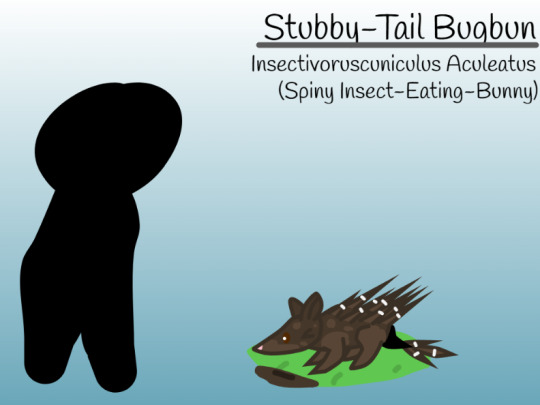
The Stubby-Tail Bugbun (Insectivoruscuniculus Aculeatus) Is an more typical member of the Hedgey family, being an insectivore and possesing though quills at their back and tuff.
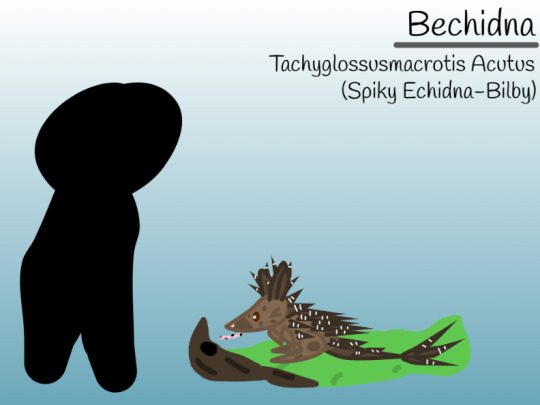
The Bechidna (Tachyglossusmacrotis Acutus) Is the tropical Hedgey, using Its claws to destroy termite hills and break away rotten wood and long tongue to slurp up the insects.
Its quills cover Its entire back, even the ears and the tail are packed with quills.
2 notes
·
View notes
Text
Treasure The Rodent - Mausbies Of The Late Origocene
(20 Million Years P.E.)
The Middle Origocene saw the rise of the Mausbies, small rodent analogues, In the niche of seedeaters or small scale omnivores.
But now In the Late Origocene the Mausbies saw alot more diversity trying to cover still avaible niches or make a living In new Habitats.
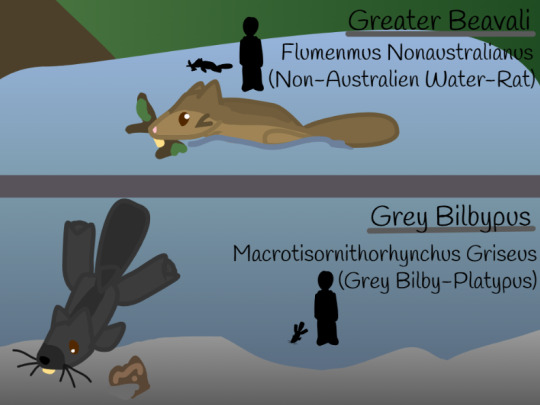
The Beavalis are descendants of the Rattuffs which have adapted to an semi-aquatic lifestyle.
Similiar to the Shell-Fishers 10 Million years prior they have adapted an mechanism that allows them to seal their pouch when underwater, preventing their joeys from drowning.
The Greater Beavali (Flumenmus Nonaustralianus) Is one of the more basal species.
Their strong incisors are perfectly adapted for crushing the hard shells of mussels and crustaceans, but also for breaking wooden bark. Similiar to earthern Beavers, the Greater Beavali builds dams which can controll the river streams, giving them the perfect conditions to build their nests, find and store food as well as giving them an safe place to rest.
The Grey Bilbypus (Macrotisornithorhynchus Griseus) Is an fellow widespread Beavali species, It posses long sensitive whiskers which It uses to find arthropods and other goods hidden under the river bed.

Another clade of Rattuff are the Hampters, as their name suggest they have heavily converged with earthern hamsters.
They posses an small, round body with an short tail, but those are not all features they took from the earthern hamster, as they also have the hamsters signature trait, cheek pouches.
Their flexible cheeks help them to hord all of the goods they find, saving time foraging, which makes them visible to predators.
The Field Hampter (Pseudocricetus Ager) Is an plains dwelling small-scale herbivore feeding on seeds, roots, vegetables and various grasses. Field Hampters are one of the few unsocial Mausby species, not forming family colonies and only interacting with another when mating.
The Greater Dwarf Hampter (Nainuspseudocricetus Maxillutus) Is pretty similiar to Its larger cousin, although they are not herbivores but rather omnivores, eating seeds, roots and insects.
They also havent completly abondend their colonies, althought the family bonds are very loose and tend to fall apart quickly.
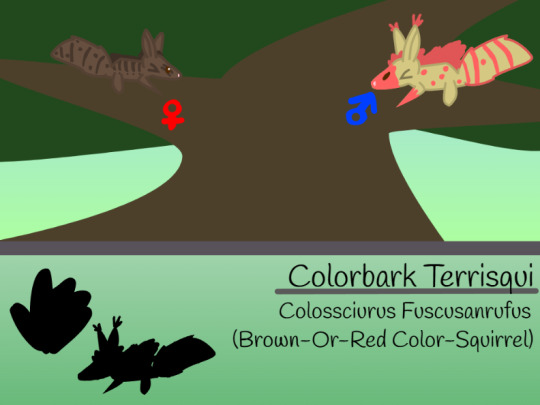
Talking about unsocial Mausbies, we have the Terrisquis, an clade of Squruffies, solitary Mausbies that by now have become incredibly territorial and even straight up aggressive animals.
Similiar to the Hampters the Terrisqui have found an way to take their food to go, but instead of developing cheek pouches, they used an feature they already possed and have just modified It a bit, as the Terrisquis use their marsupial-pouches to store their food.
This alsomeans that both the males and the females posses pouches to store food, we see something similiar In earthern Yapoks, marsupials In which both males and females posses pouches.
Also similiar to the Yapok they posses an mechanism that allows them to seal their pouch, the same Shell-Fishers and the Beavalis posses, this prevents their food from accidentally falling out of their pouch.
The Colorbark Terrisqui (Colossciurus Fuscusanrufus) Is an pretty basal member of the Terrisqui family.
The females sport an camouflaging brown color, while the males are alot more eye-stinging. As territorial as the Terrisquis are, the males have evolved an brighter fur color to make their presence clear to rivals. The males also posses the ability to make the fur on their back stand up, In turn making them appear larger to predators and rivals.
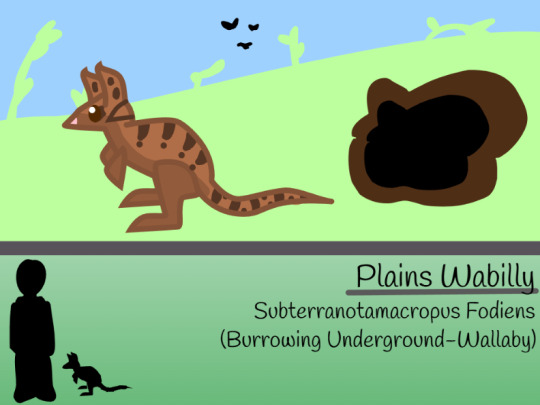
Back to the more peacefull and social creatures, we have the Wabillies. Plains dwelling descendants of the Jerbaroos.
Normally the desert Is the kingdom of the Jerbaroos, with the plains dwelling individualls standing In the shadow of their relatives, but the Wabillies managed to stay relevant amongst the competetion.
As of right now the Wabillies are the largest Mausbies to ever exist, turns out, living In the plains among swarms of Pterobats of prey, being big has Its benefits.
The Plains Wabilly (Subterranotamacropus Fodiens) Is the most common species of the rather small Wabilly family.
They live In huge family colonies and burrow equally huge, complex burrows. They are omnivores eating whatever they can find, vegetables, seeds, insects and even the occasional small marsupial.
#speculative evolution#spec evo#speculative biology#speculative zoology#art#digital art#evolution#world building#creature design#spec bio#macroterra
0 notes
Text
Macroterra - The Middle Origocene
10 Million Years P.E.
#speculative evolution#spec evo#speculative biology#speculative zoology#art#digital art#evolution#world building#creature design#spec bio#macroterra
0 notes
Text
Repost Of The Map Of The Early and Middle Origocene

1 note
·
View note
Text
Pop Goes The Measel - The Measels
10 Million years P.E. [The Middle Origocene]
The Tearlings and the Bepples were the first carnivores on Macroterra to emerge 9 million years ago.
But while Tearlings specialised In other Bilbies, the Bepples were insect eaters, untill some of their recent descendants, the Measels (Family: Mustelamacrotidae).
Measels are carnivores like their ancestors but have started to add other Bilbies into their insectivorous diet, some still eat mostly insects, but some have completly moved on to a diet consisting of small marsupials.
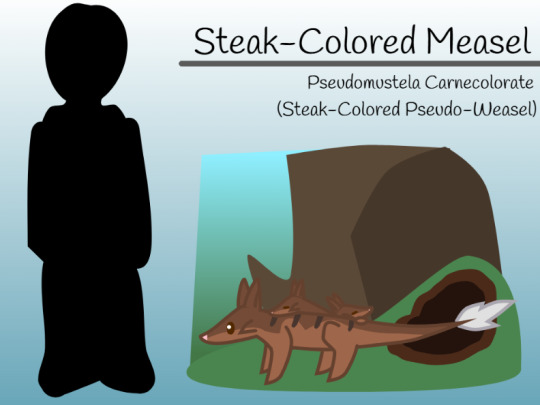
The Steak-Colored Measel (Pseudomustela Carnecolorate) Is one of the more basal species.
They are meso- ambush predators which eat both insects and small Bilbies.
The Steak-Colored Measel also shows an trait not often found In marsupials, parental care.
In most marsupials the mother wont interact much with their baby and will kick It out of the pouch once too heavy.
Most Measels will still carry around their joeys on their back after they have outgrown their pouch, showing them how to hunt and find insects, the mother will also protect the joeys from other meso-predators that might try to eat them.
The Steak-Colored Measel reproduces rather slow, once every few weeks they will mate and raise up to 2 joeys at a time.
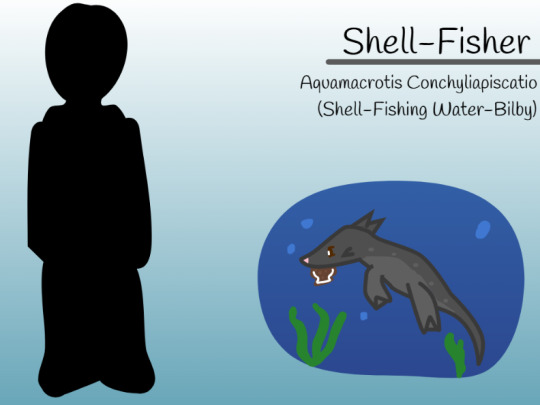
The Shell-Fisher (Aquamacrotis Conchyliapiscatio) Is another rather odd marsupial, as their are semi-aquatic.
Semi-aquatic marsupials are difficult, as mothers would drown their joeys when diving Into water.
On earth we only ave one semi-aquatic marsupial the Yapok.
As a result the Shell-Fisher has heavily converged with the Yapok, evolving the same mechanism allowing them to seal their pouch watertight, they achieve this with an muscular mechanism that cinches the pouch closed.
With this mechanism the Shell-Fisher mother can dive Into rivers without drowning their joeys.
The Shell-Fishers themself will like the Steak-Colored Measel raise an max of 2 joeys, less joeys require less air, thus the mother can dive longer then if she would raise more.
They although dont interact much with their joeys after leaving the pouch, unlike many other Measels.
Underwater the Shell-Fishers will seek out hard shelled prey like mussels.

The Pale-Faced Tree Measel (Mustelaarboris Pallidafacies) Is an arboreal entry of the Measel family, they are one of the few Tree Measels that only feed on other Bilbies and dont show parental care.
They are excellent climbers and feed on other arboreal critters like Squruffies or Bilcoons.
#speculative evolution#spec evo#speculative biology#speculative zoology#evolution#art#digital art#world building#macroterra
1 note
·
View note
Text
Soon, Bilcoon - The Bilcoons
10 Million years P.E. [The Middle Origocene]
While many of the Bilbies started to specialize In specific niches such as, predators, seedeaters and grazers, some Bilbies remained omnivores, some have even expanded their diet, eating pretty much everything. One of those creatures on Macroterra would be the Bilcoons (Family: Procyonmacrotidae), oppurtunistic omnivores eating seeds, fruits, veggies, insects, carrion and even smaller Bilbies.
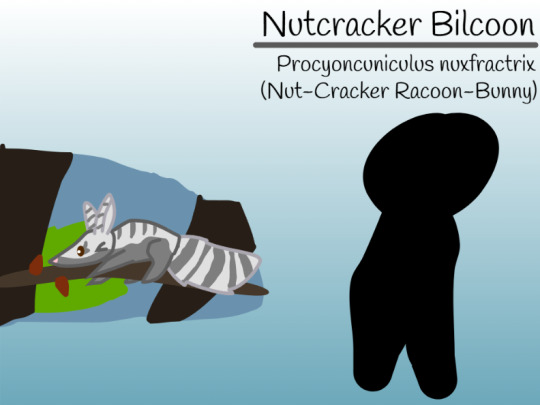
The Nutcracker Bilcoon Is one of the most common Bilcoons In the middle Origocene. Like most of the Bilcoons they are semi-arboreal, feeding on the goods up there, the Nutcracker Bilcoon Is one of the ´Coons that eats mostly seeds and nuts.
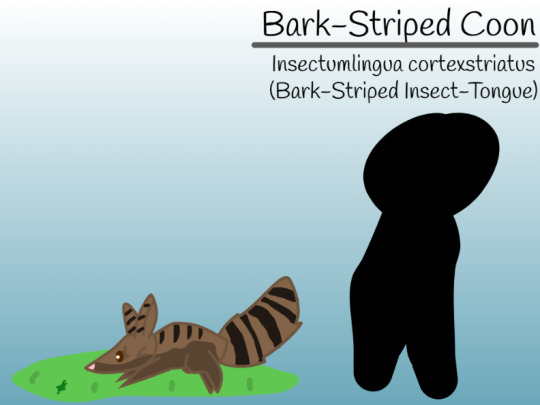
An more carnivorous member of the Bilcoon family Is the Bark-Striped Coon (Insectumlingua Cortexstriatus), this Bilcoon feeds mostly on quick and evasive insects, both on solid floor and on the ground.
1 note
·
View note